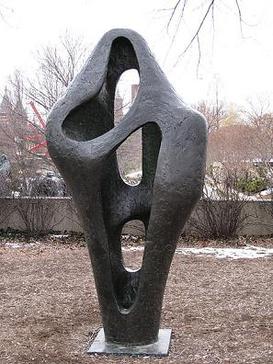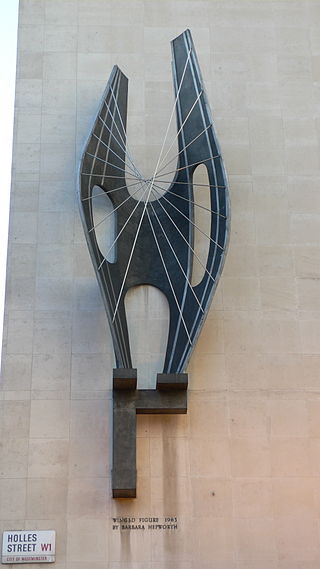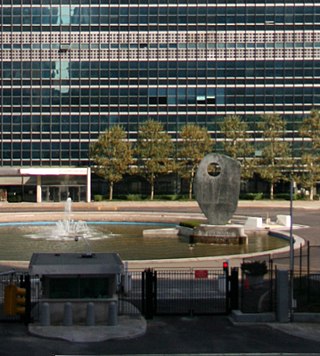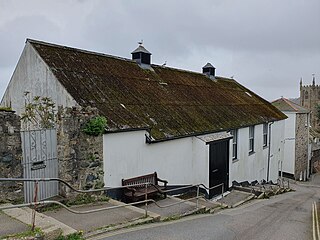
Dame Jocelyn Barbara Hepworth was an English artist and sculptor. Her work exemplifies Modernism and in particular modern sculpture. Along with artists such as Ben Nicholson and Naum Gabo, Hepworth was a leading figure in the colony of artists who resided in St Ives during the Second World War.

Henry Spencer Moore was an English artist. He is best known for his semi-abstract monumental bronze sculptures which are located around the world as public works of art. Moore also produced many drawings, including a series depicting Londoners sheltering from the Blitz during the Second World War, along with other graphic works on paper.

Sir William Goscombe John was a prolific Welsh sculptor known for his many public memorials. As a sculptor, John developed a distinctive style of his own while respecting classical traditions and forms of sculpture. He gained national attention with statues of eminent Victorians in London and Cardiff and subsequently, after both the Second Boer War and World War I, created a large number of war memorials. These included the two large group works, The Response 1914 in Newcastle upon Tyne and the Port Sunlight War Memorial which are considered the finest sculptural ensembles on any British monument.
L’Homme qui marche I is the name of any one of the cast bronze sculptures that comprise six numbered editions plus four artist proofs created by Swiss sculptor Alberto Giacometti in 1961. On 3 February 2010, the second edition of the cast of the sculpture became one of the most expensive works of art ever sold at auction, for $104.3 million. Its price meant it was considered the most expensive sculpture, until May 2015, when another Giacometti work, L'Homme au doigt, surpassed it.

Two Figures is a bronze sculpture by the English sculptor Barbara Hepworth, which was cast in an edition of seven copies. One of these is located at Newfields, the campus that also houses the Indianapolis Museum of Art in Indianapolis, Indiana. Other casts are at Southampton University, the Fred Jones Jr. Museum of Art at the University of Oklahoma, Commonwealth Park in Canberra Australia, and the Hakone Open-Air Museum, Hakone, Japan. The series were cast at the Morris Singer Foundry in London from 1968 onwards. Another cast of this work could also be found at the University of Birmingham Vale site, but is no longer present as of January 2, 2012.

Figure for Landscape is a bronze sculpture by Barbara Hepworth, modeled in 1960.

Cardiff University School of Music is the music department of Cardiff University and is located in Cardiff, Wales. It is home to about 240 undergraduate and 40 postgraduate students. It was one of the first departments established when Cardiff University was granted its Royal Charter in 1883. In the 2014 Research Excellence Framework, the School's was ranked 13th in the UK in the category Music, Drama, Dance and Performing Arts. Amongst music departments, The School ranked 2nd in the UK for quality of research environment and 8th in the UK for overall research excellence. The department holds close links with organisations such as BBC National Orchestra of Wales and Welsh National Opera.

Tête de femme is a plaster-modelled, bronze-cast sculpture by Pablo Picasso. Dora Maar, Picasso's lover at the time, was the subject of the work which was originally conceived in 1941. Four copies of the bust were cast in the 1950s, several years after the relationship ended.

Sea Form (Atlantic) (BH 362) is a 1964 bronze sculpture by English artist Barbara Hepworth. It measures 204 cm × 107 cm × 73 cm (80 in × 42 in × 29 in).

Two Forms (Divided Circle) (BH 477) is a bronze sculpture by Barbara Hepworth, designed in 1969. Six numbered copies were cast, plus one (0/6) retained by the sculptor. The sculpture's dimensions are 237 centimetres (93 in) by 234 centimetres (92 in) by 54 centimetres (21 in).

Sphere with Inner Form is a bronze sculpture by English artist Barbara Hepworth, with six castings made in 1963 and two more 1965. It is sometimes interpreted as a child in a pregnant woman's womb, or as a metaphor for the creation of a sculpture.

Winged Figure is a 1963 sculpture by British artist Barbara Hepworth. One of Hepworth's best known works, it has been displayed in London since April 1963, on Holles Street near the junction with Oxford Street, mounted on the south-east side of the John Lewis department store. It is estimated that the sculpture is seen by approximately 200 million people each year.

Spindle Piece is a bronze sculpture series by Henry Moore. Unusually, the sculpture was made in four sizes: a plaster maquette cast in bronze as Maquette for Spindle Piece in 1968, a larger plaster working model which was also cast in bronze as Spindle Piece in 1968, a larger series of bronze sculptures Large Spindle Piece cast in 1974, and the largest model, known as The Spindle, carved in travertine in 1981.

Single Form is a monumental bronze sculpture by the British artist Barbara Hepworth. It is her largest work, and one of her most prominent public commissions, displayed since 1964 in a circular water feature that forms a traffic island at the Headquarters of the United Nations in New York City, outside the United Nations Secretariat Building and the Dag Hammarskjöld Library. It is also the largest artwork cast by the Morris Singer foundry.
Meridian is a bronze sculpture by British artist Barbara Hepworth. It is an early example of her public commissions, commissioned for State House, a new 16-storey office block constructed at 66–71 High Holborn, London, in the early 1960s. The sculpture was made in 1958–59, and erected in 1960. When the building was demolished in 1992, the sculpture was sold and moved to the Donald M. Kendall Sculpture Gardens in Purchase, New York.

Three Piece Reclining Figure: Draped 1975 is a bronze sculpture by Henry Moore, catalogued as LH 655. It is approximately 4.7m long. Seven casts and an artist's proof were made. Three publicly exhibited casts are situated in the Sodra Kungsgatan in Gävle, Sweden, at the Massachusetts Institute of Technology in Boston, USA, and the Henry Moore Foundation in Perry Green, Hertfordshire.

Jacob Epstein's bronze bust of Winston Churchill was completed in 1947 and cast in an edition often said to number 10. Epstein was commissioned by the War Artists Advisory Committee to create a sculpture of former British prime minister Winston Churchill in August 1945, after the end of the Second World War and shortly after Churchill lost the 1945 UK general election. Two casts have been previously displayed in the Oval Office. Another remains on display in the atrium of Churchill College, Cambridge.

Four-Square is a 4.3 metres (14 ft) high bronze sculpture by British artist Barbara Hepworth. It was cast in 1966 in an edition of 3+1. The four casts are displayed at the Barbara Hepworth Museum, the Norton Simon Museum, Churchill College, Cambridge, and the Mayo Clinic.

Hester Diamond was an American art collector, dealer, and interior designer. With her first husband, Harold Diamond, she amassed a collection of Modernist art that the New York Times described as "astonishing". Following her husband's death, Diamond switched her focus to Old Masters, assembling "one of the greatest, most idiosyncratic art collections in America". She was the mother of Mike D of the Beastie Boys.

The Palais de Danse is a former cinema, dance hall, ballet school and auction house in St Ives, Cornwall which was a studio for sculptor and artist Barbara Hepworth from 1961 until her death in 1975. After her death, the Palais was kept by her family until it was donated to Tate in 2015. In 2020, Historic England designated it a Grade II listed building.




























